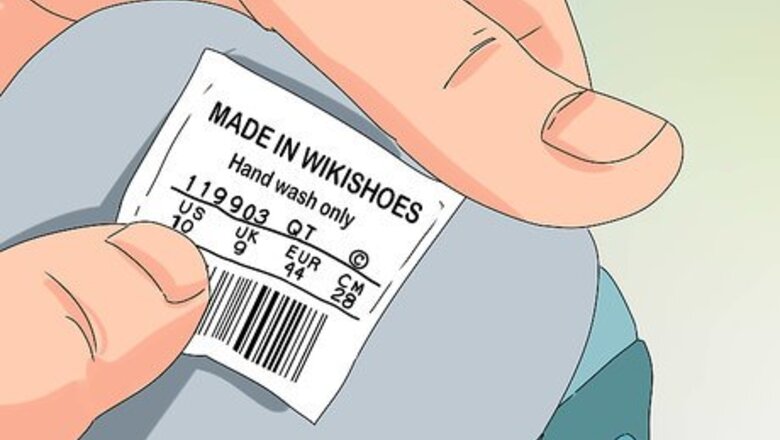
views
Using the Washing Machine
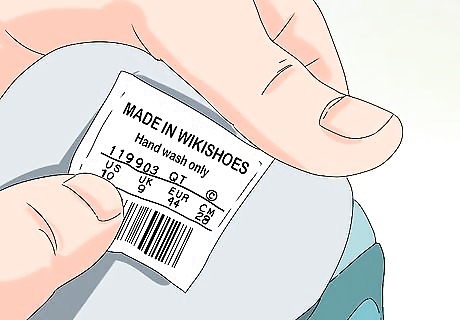
Check the label to make sure it’s safe to machine wash your shoes. Most sneakers can be cleaned in the washing machine, but it’s always a good idea to double-check beforehand. If the label says “hand wash only,” you may want to consider cleaning the shoes by hand. If your shoes don’t have a label, search the brand online to get cleaning recommendations. If your shoes have any leather or suede, it is not a good idea to machine wash them, as the water can damage those parts of the shoes.

Use a scrub brush to brush away any visible clumps of dirt. Preferably, do this over a trash can or outside to keep the dirt from getting all over your floor. If the dirt is wet, let it dry completely first. Dry dirt brushes away more easily than wet dirt does. Removing as much dirt as possible before washing the shoes will help them get cleaner in the washing machine.
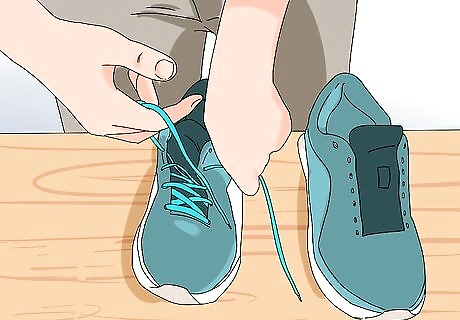
Remove the laces and treat dirty sections with laundry detergent. Check them out to see if there are any areas that are particularly dirty. If so, take a little bit of laundry detergent and use your fingers to rub it into the shoelaces. This pretreating will help the dirt come out more easily. Put the laces into their own small mesh bag to keep them from wrapping around other items when they’re in the wash.
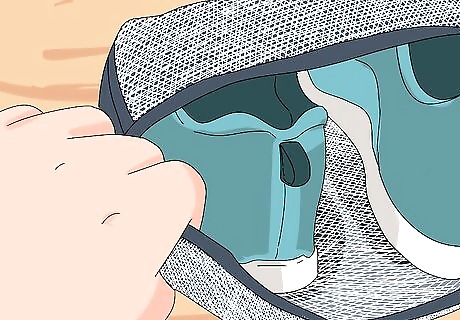
Put the shoes into a mesh bag and wash them along with towels. If you don’t have mesh laundry bags, you can buy them online or at department stores for about $10. Put the bag with your shoes in it, the one with the laces, and a load of towels into the washing machine. Washing the shoes along with towels keeps the shoes from banging around in the washing machine, which could potentially damage your shoes or the machine itself.
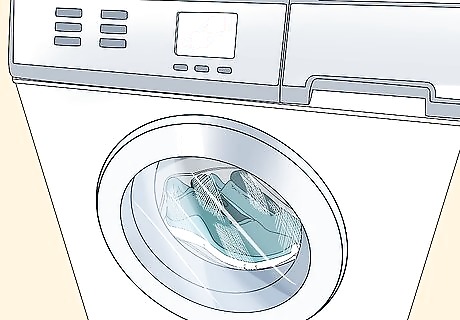
Run a gentle cycle with cool water. Use the same amount of detergent you normally would, and avoid using hot water. Choose the gentle cycle if you have the option. Don’t overdo it on the detergent. Excess detergent can cause soap residue to build up on your shoes, making them stiff and possibly even staining them.

Let the pair of shoes air dry. You can put them in front of a dehumidifier, a fan, or an open window, but avoid putting them in front of any type of heat source or into the dryer. If the shoes have insoles, take them out and let them dry separately to speed up the process. You might be tempted to toss your sneakers into the dryer so you can wear them sooner, but doing so could ruin the shape of your shoes. The high heat could warp plastic or synthetic fibers. To help the shoes keep their shape, stuff the insides with crumpled newspaper.
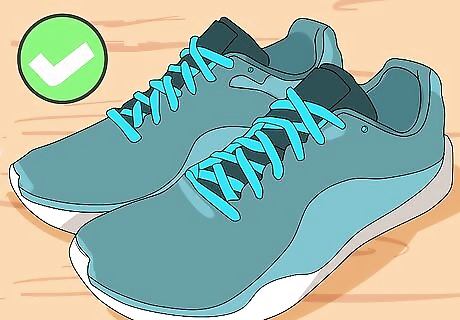
Reassemble the shoes once everything is completely dry. It should take anywhere from 8 to 12 hours for your shoes to dry, just depending on whether or not you do anything else to speed up the process. Once they’re dry, put the insoles back in place and re-lace them. If your shoes still look really dirty, you may need to treat the soles separately or perhaps try putting them through the laundry again. If you can’t get them clean, it may be time to invest in a new pair of sneakers.
Washing Sneakers by Hand
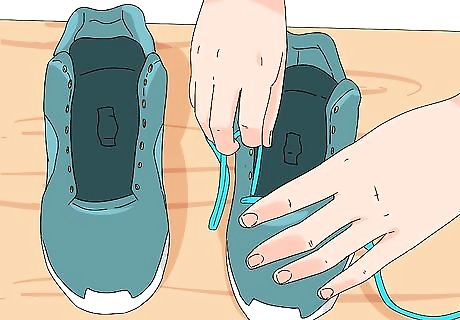
Remove the laces from your shoes. As you take out the laces, pay attention to their condition—are they grungy? Are they fraying? If they’re just dirty, you’ll be able to clean them, but if they’re fraying and threadbare, it may be time to buy a new pair. If you do need to buy new laces, measure your current ones to see what length they are. That way, you’ll be sure to purchase replacements that are long enough for your shoes.

Rub laundry detergent into the stained areas of the laces. For this purpose, it’s helpful to pour a small amount of laundry detergent into a bowl; 1 to 2 tablespoons (15 to 30 mL) should do. Dip your finger into the laundry detergent, and then rub it into grungy sections of your shoelaces. Repeat this step until both laces have been treated. Rubbing the laundry detergent into the laces causes the soap to start reacting with and breaking down the ground-in dirt.

Rinse the laces with warm water and pat them dry with a clean towel. Take your shoelaces to the sink, and turn the water on to warm. Rinse each shoelace, taking time to rub along the entire length to remove all the dirt and soap. Keep rinsing until the water runs clear and your laces are clean. Dry them off with a clean towel and set them to the side. If your laces are particularly dirty, you could also fill your sink with warm water and leave the shoelaces to soak for 10 to 15 minutes while you clean the rest of your shoes.
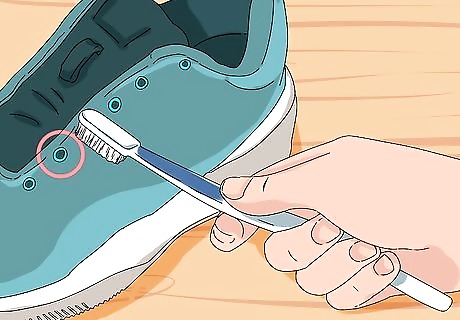
Clean the eyelets with a toothbrush and a little bit of laundry detergent. The eyelets are the little holes that the shoelaces wind through. Continue using the small bowl of laundry detergent from earlier, and dip a clean toothbrush into it. Scrub the eyelets with the toothbrush to remove any built-up dirt or grime, then wipe them clean with a damp sponge. When rinsing away the laundry detergent, avoid using an overly-wet sponge. Wet the sponge then wring it out so it’s not dripping wet. This’ll keep the suds from spreading too far and your shoes won’t get over-saturated.
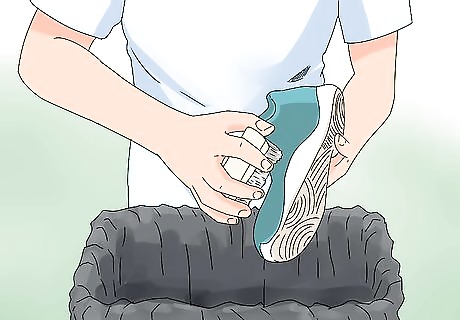
Dislodge dry dirt with a small scrub brush. Pick up your shoes and examine them. If there are dry clumps of dirt or grass, brush them away with a small scrub brush. Do this over a trashcan or outside to keep the dirt from getting all over your floor. Don’t try to brush away dirt that is still wet. Let it dry completely first—it’ll be much easier to remove once it’s dry. If there are stuck pebbles, use a pair of tweezers to scrape them out.
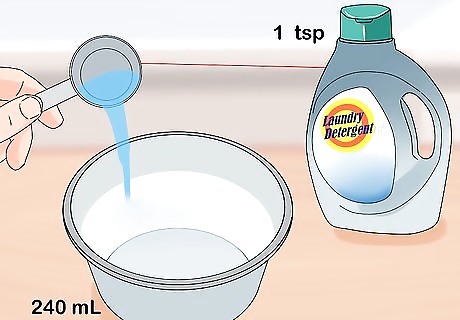
Mix together 1 tsp (4.9 mL) of laundry detergent and 1 c (240 mL) of water. Depending on how much laundry detergent is left in your bowl after cleaning the shoelaces and eyelets, you may not need to add more. Stir the water and laundry detergent together until the mixture is sudsy. It doesn’t matter if you use warm or cold water. The laundry detergent will dissolve easily in either one.
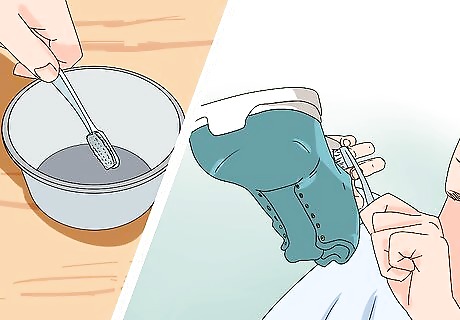
Wet a toothbrush in the mixture and scrub the entirety of the shoes. You can use the same toothbrush you used to clean the eyelets, or you could even use the small scrub brush from earlier. Whatever you choose to use, dip it into the laundry detergent and water mixture, and then proceed to scrub the entire body of each shoe. Clean the body of the shoe, the tongue, the soles, and even the inside of the shoe. Use a circular motion to dislodge ground-in dirt. Re-wet the toothbrush as many times as you need to while you clean. Don’t forget that insole! Remove it and clean it the same way you did the exterior of the shoe. If it still isn’t coming clean, you can always buy replacement insoles.

Wipe down the shoes with a clean, damp sponge. After you’ve scrubbed the shoes, dampen a sponge and then wring it out so it’s not dripping wet. Wipe away all the soap residue and dirt, rinsing the sponge out as often as you need to. Don’t forget to wipe down the insides and the bottoms of the shoes, too.

Let the shoes dry naturally and then lace them back up. Set the shoes to the side on a dry towel. Leave them to air dry, which should take anywhere from 8 to 12 hours. You can speed up the drying process by putting the shoes in front of a fan or an open window, but don’t put them in front of any kind of heat source because the heat could warp the shoes or even shrink them. Once they’re dry, replace the insoles and re-lace the shoes. If your shoes were really stinky, sprinkle some baking soda over the insides while they dry overnight. In the morning, knock out the excess baking soda before putting the shoes on.
Cleaning White Soles
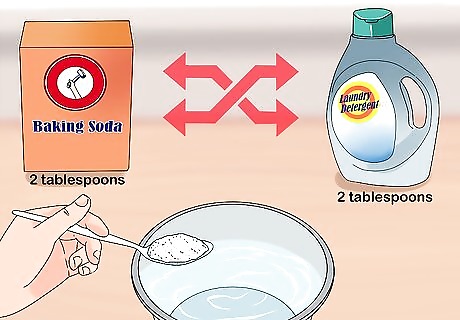
Mix together equal parts of baking soda and laundry detergent. Since you don’t need too much of either ingredient, start off with 2 tablespoons (30 grams) of baking soda and 2 tablespoons (30 mL) of laundry detergent. Stir them together to create a paste. This method works great when you simply need to spruce up the soles of your shoes but don’t need to clean the rest of them.
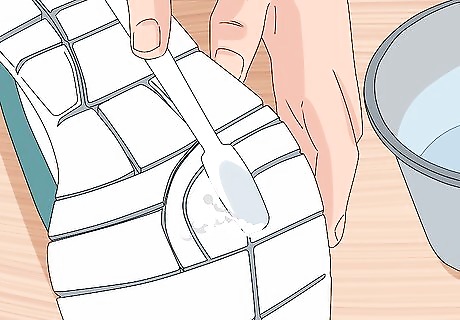
Apply the mixture to the soles with a clean toothbrush. Take a toothbrush and dip it into the baking soda and laundry detergent. Scrub it into the soles of the shoes, taking care to get all the sides and the bottoms of the shoes, too. Don’t be afraid to really pile the paste onto the soles. You can always make more if you run out, and it won’t hurt anything if you use a lot.
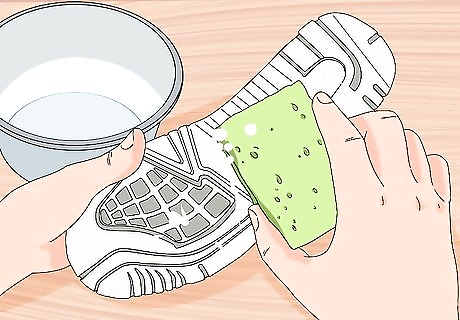
Wet a sponge with cold water and wipe away the baking soda mixture. Once you’ve scrubbed in the paste, take a sponge and saturate it with cold water. Wring it out so it’s not dripping wet, and then start to wipe away the paste from the soles. Scrub away at any areas that are still dirty, and rinse out the sponge as often as you need to. Use a sponge rather than running the shoes under a stream of water. The sponge will keep the rest of the shoe from getting wet, which means you won’t have to wait for them to dry after you’ve cleaned them.
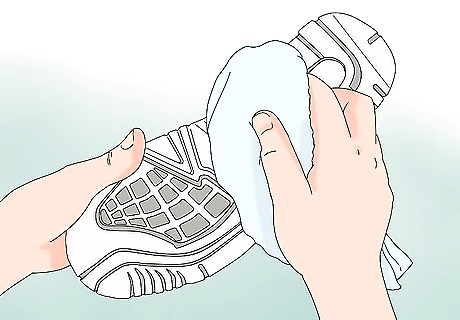
Wipe the soles down with a dry towel. Don’t forget to dry the bottoms, too, so that you don’t slip if you decide to wear them right away. Enjoy your clean shoes! If you notice any sections that are still dirty, you may want to apply a second coat of the baking soda paste to see if that helps lift the remaining dirt.




















Comments
0 comment